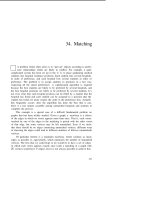Tài liệu Thuật toán Algorithms (Phần 49) doc
Bạn đang xem bản rút gọn của tài liệu. Xem và tải ngay bản đầy đủ của tài liệu tại đây (115.79 KB, 10 trang )
FAST FOURIER TRANSFORM
473
Complex Roots of Unity
It turns out that the most convenient points to use for polynomial interpolation
and evaluation are complex numbers, in fact, a particular set of complex
numbers called the complex roots of unity.
A brief review of some facts about complex analysis is necessary. The
number i = is an imaginary number: though is meaningless as
a real number, it is convenient to give it. a name, i, and perform algebraic
manipulations with it, replacing with -1 whenever it appears. A complex
number consists of two parts, real and imaginary, usually written as a bi,
where a and b are reals. To multiply complex numbers, apply the usual rules,
but replace with -1 whenever it appears. For example,
+ bi)(c + di) = (ac bd) + (ad + bc)i.
Sometimes the real or imaginary part can cancel out when a complex multi-
plication is performed. For example,
(1 i)(l =
(1 = -4,
(1 + = 16.
Scaling this last equation by dividing through by 16 = we find that
In general, there are many complex numbers that evaluate to 1 when raised
to a power. These are the so-called complex roots of unity. In fact, it turns
out that for each there are exactly N complex numbers with = 1.
One of these, named is called the principal Nth root of unity; the others
are obtained by raising to the kth power, for = . . ,N 1. For
example, we can list the eighth roots of unity as follows:
The first root,
is 1 and the second, is the principal root. Also, for
N even, the root is -1 (because = 1).
The precise values of the roots are unimportant for the moment. We’ll be
using only simple properties which can easily be derived from the basic fact
that the Nth power of any Nth root of unity must be 1.
474
36
Evaluation at the Roots of Unity
The crux of our implementation will be a procedure for evaluating a poly-
nomial of degree N 1 at the Nth roots of unity. That is, this procedure
transforms the N coefficients which define the polynomial into the N values
resulting from evaluating that polynomial at all of the Nth roots of unity.
This may not seem to be exactly what we want, since for the first step of
the polynomial multiplication procedure we need to evaluate polynomials of
degree N 1 at 2N 1 points. Actually, this is no problem, since we can view
a polynomial of degree N 1 as a polynomial of degree 2N 2 with N 1
coefficients (those for the terms of largest degree) which are 0.
The algorithm that we’ll use to evaluate a polynomial of degree N 1
at N points simultaneously will be based on a simple divide-and-conquer
strategy. Rather than dividing the polynomials in the middle (as in the
multiplication algorithm in Chapter 4) we’ll divide them into two parts by
putting alternate terms in each part. This division can easily be expressed in
terms of polynomials with half the number of coefficients. For example, for
N = 8, the rearrangement of terms is as follows:
The Nth roots of unity are convenient for this decomposition because if you
square a root of unity, you get another root of unity. In fact, even more is
true: for N even, if you square an Nth root of unity, you get an root of
unity (a number which evaluates to 1 when raised to the power). This
is exactly what is needed to make the divide-and-conquer method work. To
evaluate a polynomial with N coefficients on N points, we split it into two
polynomials with coefficients. These polynomials need only be evaluated
on points (the roots of unity) to compute the values needed for the
full evaluation.
To see this more clearly, consider the evaluation of a degree-7 polynomial
p(x) on the eighth roots of unity
Since = -1, this is the same as the sequence
:
Squaring each term of this sequence gives two copies of the sequence of
the fourth roots of unity:
THE FAST
475
Now, our equation
tells us immediately how to evaluate at the eighth roots of unity from
these sequences. First, we evaluate and at the fourth roots of unity.
Then we substitute each of the eighth roots of unity for x in the equation
above, which requires adding the appropriate value to the product of the
appropriate value and the eighth root of unity:
=
= +
= +
= +
=
=
=
=
In general, to evaluate p(x) on the Nth roots of unity, we recursively evaluate
p,(x) and on the roots of unity and perform the N multiplications
as above. This only works when N is even, so we’ll assume from now on that
N is a power of two, so that it remains even throughout the recursion. The
recursion stops when N = 2 and we have to be evaluated at 1 and
-1, with the results + and -pi.
The number of multiplications used satisfies the “fundamental
and-conquer” recurrence
M(N) = + N,
which has the solution M(N) = N lg N. This is a substantial improvement
over the straightforward method for interpolation but, of course, it works
only at the roots of unity.
This gives a method for transforming a polynomial from its representation
as N coefficients in the conventional manner to its representation in terms of
its values at the roots of unity. This conversion of the polynomial from the
first representation to the second is the Fourier transform, and the efficient
recursive calculation procedure that we have described is called the “fast”
Fourier transform (FFT). (These same techniques apply to more general
functions than polynomials. More precisely we’re doing the “discrete” Fourier
transform.)
476 CHAPTER 36
Interpolation the Roots of Unity
Now that we have a fast way to evaluate polynomials at a specific set of points,
all that we need is a fast way to interpolate polynomials at those same points,
and we will have a fast polynomial multiplication method. Surprisingly, it
works out that, for the complex roots of unity, running the evaluation program
on a particular set of points will do the interpolation! This is a specific instance
of a fundamental “inversion” property of the Fourier transform, from which
many important mathematical results can be derived.
For our example with = 8, the interpolation problem is to find the
polynomial
which has the values
s2,
As we’ve said before, the interpolation problem is the “inverse” of the evalua-
tion problem. When the points under consideration are the complex roots of
unity, this is literally true. If we let
then we can get the coefficients
just by evaluating the polynomial s(x) at the inverses of the complex roots of
unity
8 8 8
which is the same sequence as the complex roots of unity, but in a different
order:
8'
In other words, we can use exactly the same routine for interpolation as
for evaluation: only a simple rearrangement of the points to be evaluated is
required.
The proof of this fact requires some elementary manipulations with finite
sums: those unfamiliar with such manipulations may wish to skip to the end
of this paragraph. Evaluating at the inverse of the tth Nth root of unity
FAST FOURLER TRANSFORM 477
gives
=
=
Nearly everything disappears in the last term because the inner sum is trivially
N if i = t: if i t then it evaluates to
j(i-t) N
Note that an extra scaling factor of N arises. This is the “inversion theorem”
for the discrete Fourier transform, which says that the same method will
convert a polynomial both ways: between its representation as coefficients and
its representation as values at the complex roots of unity.
While the mathematics may seem complicated, the results indicated are
quite easy to apply: to interpolate a polynomial on the Nth roots of unity,
use the same procedure as for evaluation, using the interpolation values as
polynomial coefficients, then rearrange and scale the answers.
Implementation
Now we have all the pieces for a divide-and-conquer algorithm to multiply
two polynomials using only about N lg N operations. The general scheme is
to:
Evaluate the input polynomials at the (2N roots of unity.
Multiply the two values obtained at each point.
Interpolate to find the result by evaluating the polynomial defined by
the numbers just computed at the (2N roots of unity.
The description above can be directly translated into a program which uses a
procedure that can evaluate a polynomial of degree N 1 at the Nth roots
of unity. Unfortunately, all the arithmetic in this algorithm is to be complex
arithmetic, and Pascal has no built-in type complex. While it is possible









